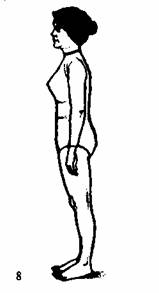| Yoga : Samasthiti |
|
Standing Upright Posture: Samasthiti Sama means 'upright' or 'erect', and sthiti means 'steadiness'. This is the basic standing pose in Hatha Yoga, and the starting position for most of the standing postures. In this posture you stand erect and steady, feet together, arms by sides, head, neck, spine, pelvis, legs, and feet forming a straight, but poised rather than rigid, vertical. By standing sideways to a full-length mirror and swivelling your eyes, you can observe how far your posture matches that depicted in our illustration. (A frank observer is even better; or be photographed front, back, and side views.) There are two fundamental deviations from the poised standing posture. Slouching, round-shouldered, flat-chested, with protruding and sagging stomach, is one common fault. Equally harmful is a stiff, exaggeratedly-erect stance, pigeon-chested, back arched, head pulled back; this compresses the spine and damages health with its rigidities. One may have these faults in a minor or major degree. Adopt each of these two erroneous postures in an exaggerated way, and note that each has a characteristic psychological as well as physical tone. Poised posture is the only posture that imparts a psycho-physical feeling tone that is in accord with Yoga: one of alertness, balance, integrated energies, and wholeness. It is the life-feeling itself, firmly rooted in Nature, which the Chinese call the Tao. In the poised posture the chin is held level and the head balances easily on the neck; the spine is straight, with no hump where it joins the neck; the thorax is naturally lifted (not deliberately thrust out) and deep; the pelvis feels centred and firm; and the legs firmly support the body, whose weight is evenly distributed over both feet and the full length of each foot. There is a sense of uplift and 'thinking high'. The abdomen is gently braced, feels firm yet pliant, and gives sound support to the abdominal viscera, which are free from downward pressures. The total feeling is of an unforced natural firmness and poise. Yoga posture should be carried into walking, and its principles (straight back, even distribution of weight, and so on) applied to lifting, pushing, pulling, and all the multifarious bodily activities of daily work and play. |
|
|
